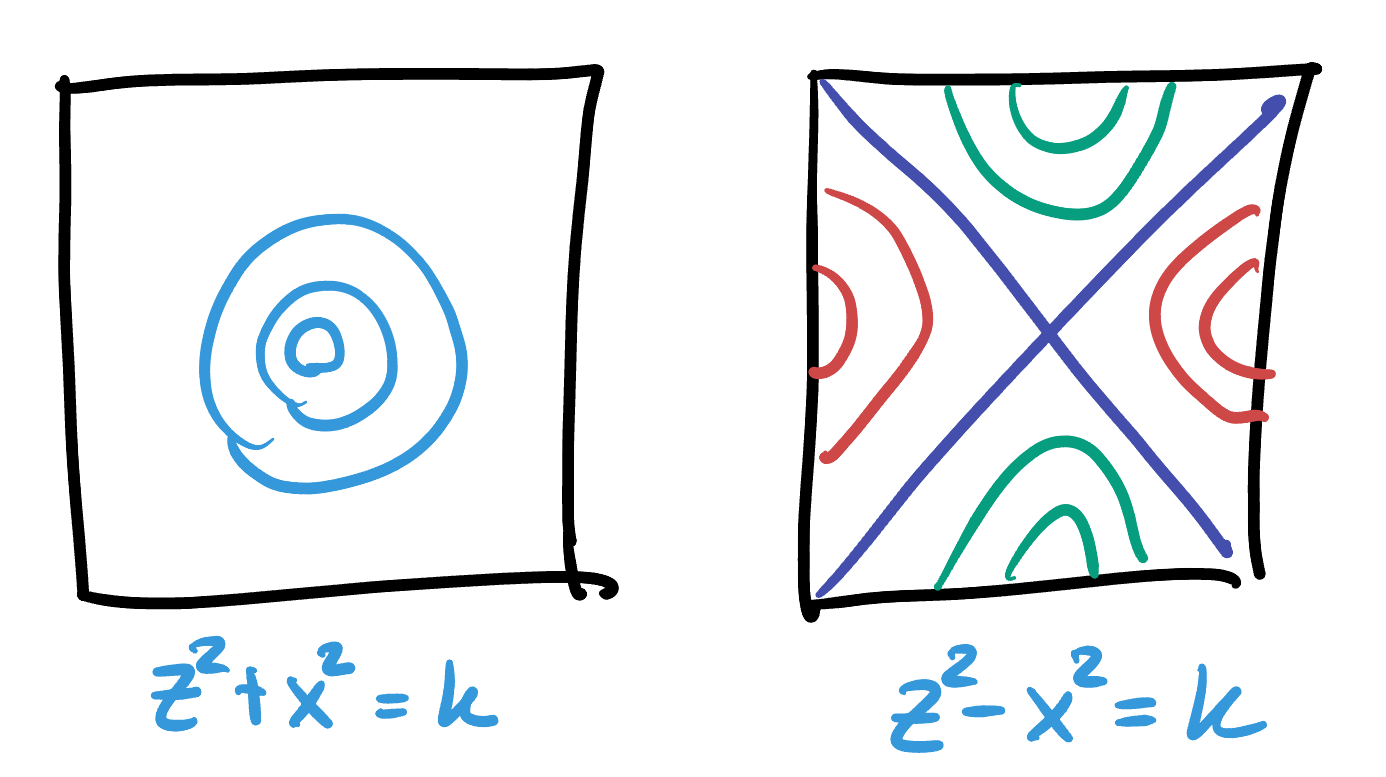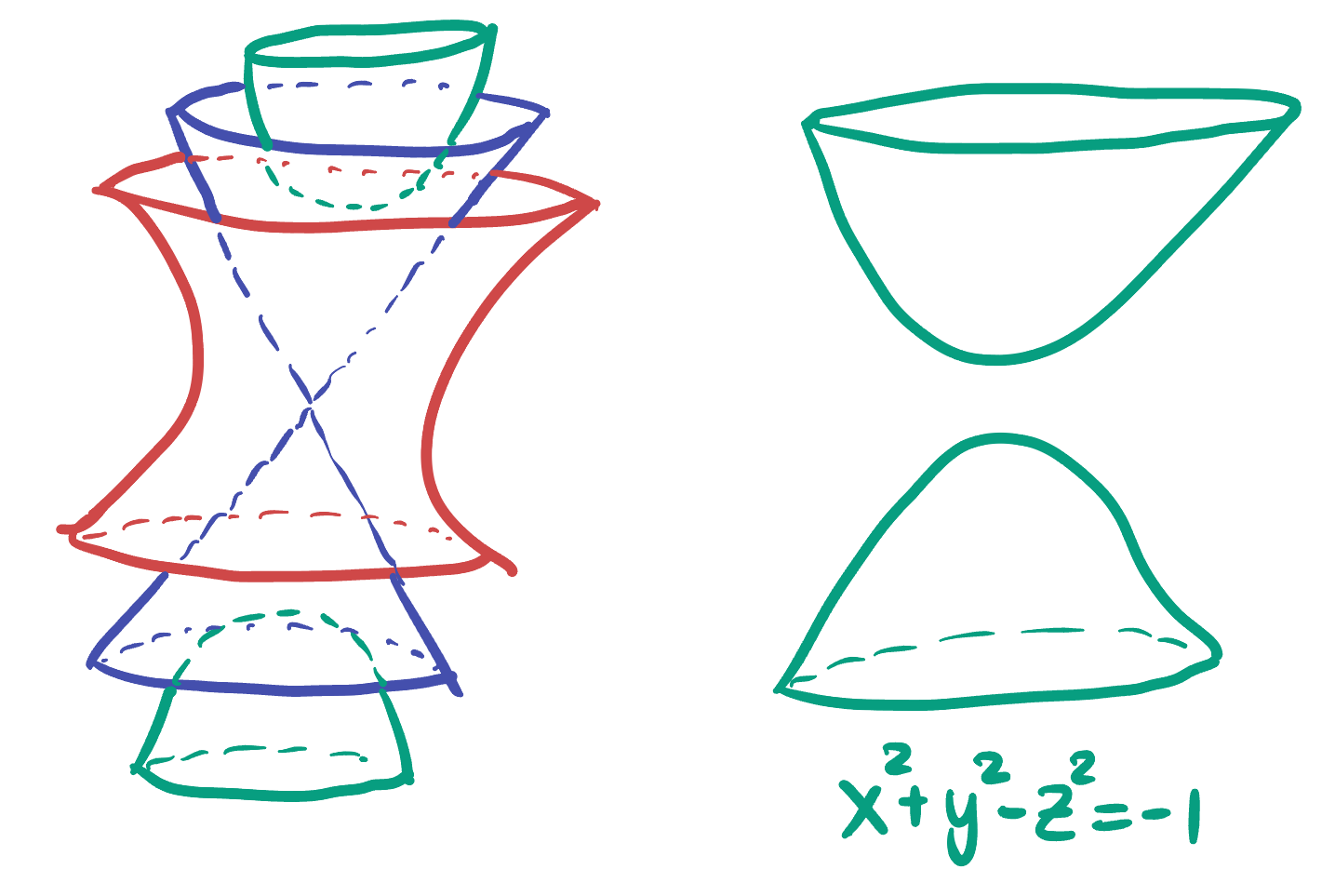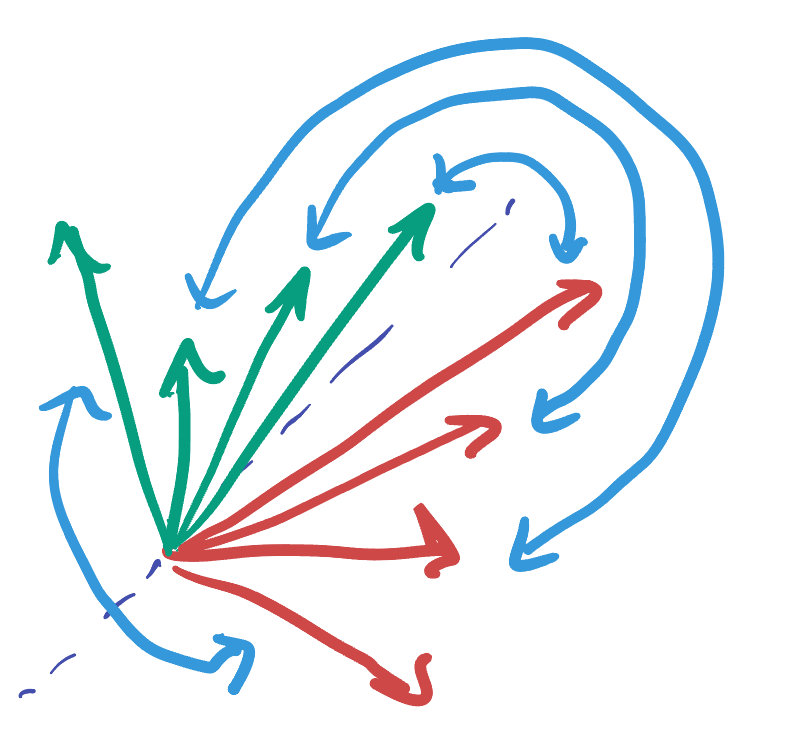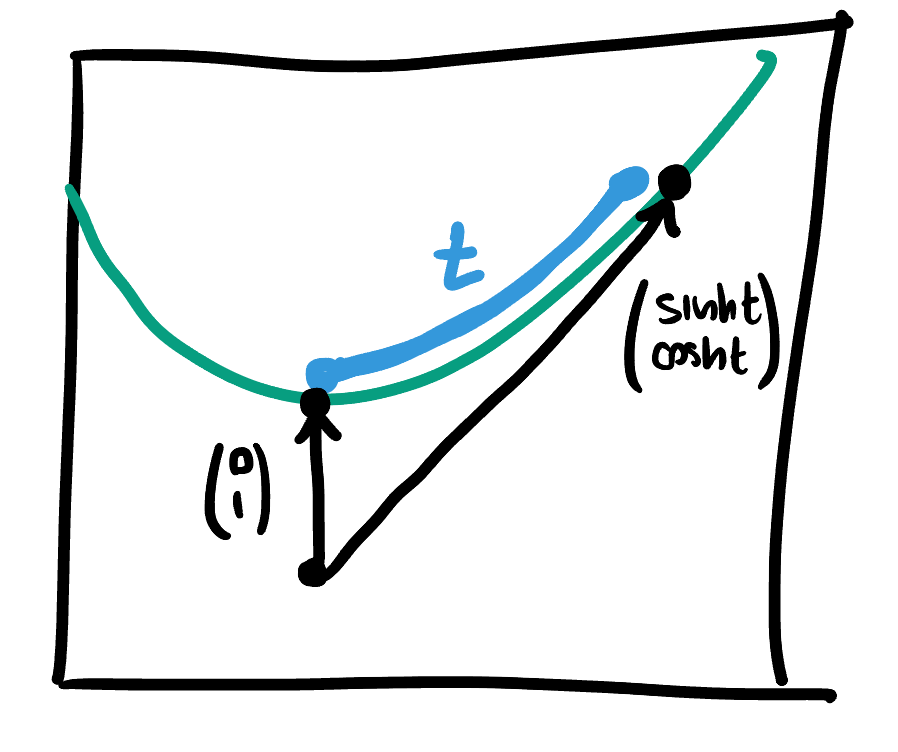29 A Strange Inner Product
In the rest of this book, we bring our tools of geometry to study an space that shares many similarities with Euclidean geometry, but one major difference right at the beginning: the dot product that we use to measure infinitesimal distances and angles has a minus sign in one place it used to have a plus.
Definition 29.1 (Minkowski Inner Product) We write

More generally, we write
Definition 29.2 Minkowski space is the 3-dimensional geometry where every tangent space is a copy of
Our primary goal is to practice using the techniques we have developed in geometry in a new an unfamiliar setting, but this particular space was chosen for a reason: there will be some exciting payoffs along the way.
This is the geometry of special relativity, but our first introduction to it actually comes through its intimate relationship to hyperbolic geometry. We will see that just like the sphere

29.1 Isometries of Minkowski Space
As a first step to understanding this, we aim to take as much of our understanding of
Definition 29.3 Recall that if
The same is true for Minkowski space, where a Minkowski isometry is any map
Theorem 29.1 Translations
Exercise 29.1 Prove this via a computation
Since a translation can take any point to any other point, we see already that Minkowski space is homogeneous. Thus, the only remaining isometries to consider are those that fix the origin (every isometry can be built as a composition of one that fixes the origin, and a translation). Studying these generally sounds difficult, so we start by studying linear isometries: recall an isometry
Theorem 29.2 Show that a linear map
This reduces the classification of linear isometries to understanding solutions of a matrix equation. We can understand such solutions in analogy with the more familiar equation
Theorem 29.3 Show that solutions of the equation
Its easy to find some such matrices, using things we already know about Euclidean geometry.
Theorem 29.4 Show that any Euclidean rotation of the
Thus, we can understand isometries that rotate the hyperboloid or exchange the two sheets easily, as they are just the Euclidean isometries we are used to! But there are more isometries of Minkowski space than just this: thinking back to the sphere in
Since we understand rotations in the
29.2 Isometries of
On this slice of the hyperboloid, our inner product has went from
This is a 2-dimensional plane with one
Theorem 29.5 Show that the Linear isometries of
The matrices given above are exactly the linear isometries of
Corollary 29.1 The linear isometries preserving the upper hyperboloid of
Its really instructive (and confusing) to use these matrices to try and understand the geometry of
Exercise 29.2 Choose some isometries (just pick some value of

29.3 Distances in Minkowski Space
Like in any of the geometries we’ve previously visited, computing the lengths of various curves in Minkowski space will teach us a lot about it, and eventually will help us track down the geodesics. There is one small difficulty in generalizing what we already know however - it’s that our inner product can now spit out negative numbers, so our definition of infinitesimal length is not well defined, as it had a square root in it. This is an easy fix: just introduce an absolute value! If
Given a definition of infinitesimal length, we can define the length of curves exactly as in Geometry class: if
Happily, since the inner product is so close to the Euclidean inner product, many simple lengths are easy to compute. The first three exercises below show this by having you find the lengths of several straight lines in the Minkowski plane. But beware - easy to compute does not mean easy to understand!
Example 29.1 In
Example 29.2 In
Example 29.3 In
In the final exercise here of ‘simple-to-compute-lengths’ we will look at measuring the length of the hyperboloid
Example 29.4 In

The length of segments of hyperbolas is a useful thing to compute in hyperbolic geometry - as these are the geodesics! The fact that this computation comes out so cleanly in the hyperboloid model is one reason this model is good for computation: in fact in almost all computer programs I write using hyperbolic geometry, I do all the computations in the hyperboloid model because of this.
29.4 Proving the Hyperboloid is Hyperbolic Space
We have learned enough about Minkowski space through its isometries and distances to embark on our main goal: proving that the hyperboloid really is a copy of hyperbolic space! Below is an approach to showing they are the same space, without constructing an isomorphism directly, which we will do so in a series of steps.
Proposition 29.1 STEP 0: The Hyperboloid is Preserved by Linear Minkowski Isometries
Proof. All linear isometries of Minkowski space preserve the inner product
Proposition 29.2 STEP I: The Hyperboloid is Homogeneous For any two points
Proof. Like in previous cases, its enough to show your favorite special point can be taken to any other point, if
Here, a natural special base point for the hyperboloid is
But now, ignoring the
Is an isometry, and this takes
Proposition 29.3 STEP II: The Hyperboloid is Constant Curvature Isometries preserve curvature, so whatever geometry this is, the curvature is the same at every point. Since its constant curvature, its either the sphere the Euclidean plane or hyperbolic space.

Proposition 29.4 (STEP III: The Curvature is Constant
Proof. To compute curvature, we need to find the formula of circumference of a circle in terms of radius
We can find circles of the hyperboloid using isometries: we know that rotations in the
Thus,
So we know the circles about
For any such
has a radius of
So
How to tell? Compute some quantity we know in these geometries: say the circumference to radius of circles. Start around (0,0,1): we found the segment of length R ends at (0,sinh R, cosh R). Thus, a circle is a horizontal circle of (Euclidean) radius sinh R. Easy to find arclength in Minkowski space is
29.4.1 Calculating Distance in the Hyperboloid
Distance between
Geodesics in hyperbolic space are equivalently (1) distance minimizing (2) straightest curves (3) lines of symmetry. Easy to find lines of symmetry of the hyperboloid: a reflection in a vertical plane is an isometry, so the geodesic from
How can we write this in a geometrically meaningful way? Note that
And so we can express the distance between points
Now that we have expressed things in terms of the Minkowski dot product, we can learn alot! The transformations we used to take our general pair of points
We can compute distances in the hyperboloid model by just using dot products! This makes something as complicated as computations in curved space reducible to linear algebra! This makes it very helpful to employ the hyperboloid model in computations done on a computer.